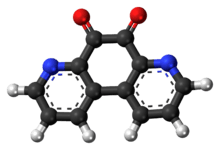Phanquinone
Not to be confused with Phenanthrenequinone.
 | |
 | |
| Clinical data | |
|---|---|
| ATC code | P01AX04 (WHO) QP51AX03 (WHO) |
| Identifiers | |
| |
| CAS Number |
84-12-8 |
| PubChem (CID) | 6764 |
| ChemSpider |
6506 |
| UNII |
ID94IS6N8J |
| KEGG |
D07359 |
| ChEBI |
CHEBI:59141 |
| ChEMBL |
CHEMBL531048 |
| ECHA InfoCard | 100.001.378 |
| Chemical and physical data | |
| Formula | C12H6N2O2 |
| Molar mass | 210.188 g/mol |
| 3D model (Jmol) | Interactive image |
| |
| |
| | |
Phanquinone is an organic compound. It is a yellowish solid derived by oxidation of phenanthroline.
It has been investigated as both antiprotozoal agent and for its bactericidal activity .[1]
References
- ↑ Mett H, Gyr K, Zak O, Vosbeck K (July 1984). "Duodeno-pancreatic secretions enhance bactericidal activity of antimicrobial drugs". Antimicrob. Agents Chemother. 26 (1): 35–8. doi:10.1128/aac.26.1.35. PMC 179912
 . PMID 6236746.
. PMID 6236746.
This article is issued from Wikipedia - version of the 6/5/2016. The text is available under the Creative Commons Attribution/Share Alike but additional terms may apply for the media files.